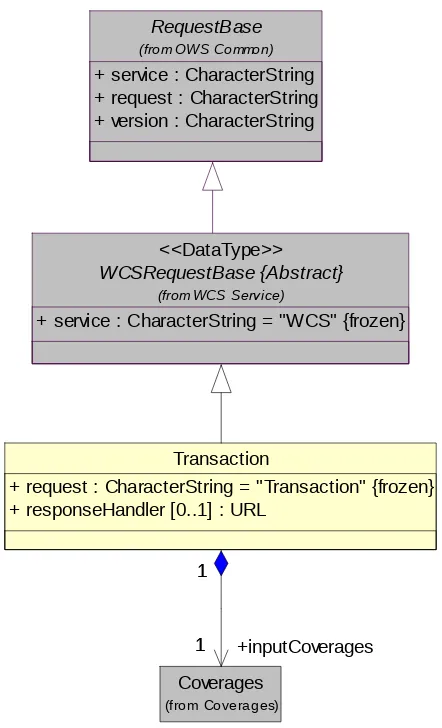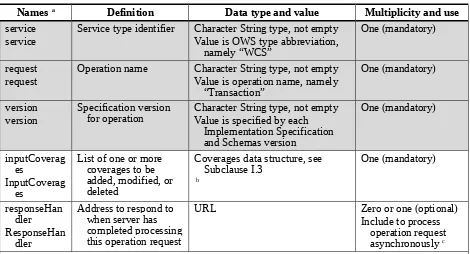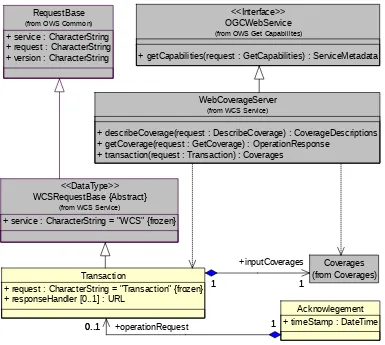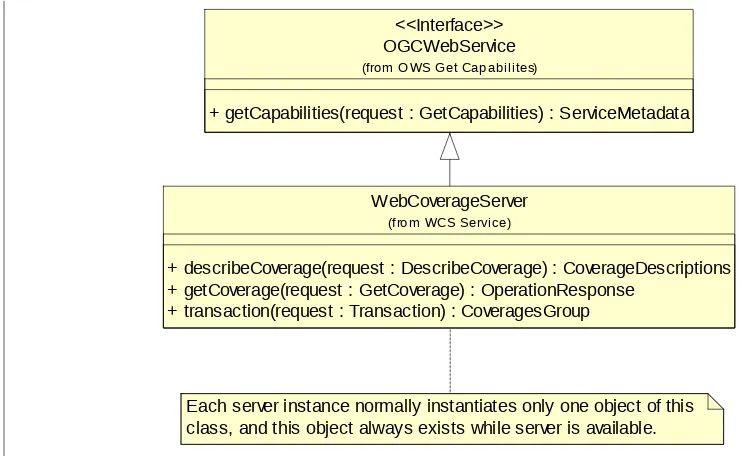CR-Form-v3
CHANGE REQUEST
WCS
CR ?
rev-
Current version: 1.1.0 For HELP
on using this form, see bottom of this page or look at the pop-up text over the symbols.
Proposed change affects: AS Imp Spec X Best Practices Paper Other
Title: WCS change request: Add Transaction operation
Source: Arliss Whiteside, OWS-4 testbed
Work item code: Date: 2007-05-02
Category: B
Use one of the following categories:
F (Critical correction)
A (corresponds to a correction in an earlier release)
B (Addition of feature),
C (Functional modification of feature)
D (Editorial modification)
Reason for change: Some applications of the Web Coverage Service (WCS) interface specification require a publicly specified, web accessible way to add or modify coverages in the set of coverages served by a WCS server
Summary of change: Specify an additional optional “Transaction” operation in the Web Coverage Service (WCS) Implementation Specification, to allow adding, modifying, or deleting coverages in the set of coverages served by a server
Consequences if
not approved:
Continued use of proprietary and/or non-web-accessible interfaces to add, modify and delete coverages in the set of coverages served by a WCS server
Clauses affected: 11 (new), 6, D.11 (new)
Other specs Other core specifications
Affected: Abstract specifications Best Practices Papers
Add the following clause to Web Coverage Service (WCS) specification:
11 Transaction operation (optional)
11.1 Introduction
The Transaction operation allows WCS clients to request that a WCS server import one or more new coverages into that server, update existing coverages, and/or delete existing coverages. This operation references (externally and attached) the data to be inserted or updated in that WCS server. It is the job of the server to resolve these references, fetch that data, and store this data for future access. This operation is optional implementation by WCS servers.
NOTE This Transaction operation is similar to the Transaction operation in the CSW protocol binding, specified in Subclause 10.11 of the Catalogue Services Specification version 2.0 [OGC 04-021r3]. This WCS operation makes use of the Coverages data structure that is specified in WCS 1.1, to support adding or modifying multiple coverages and to include metadata associated with each coverage.
The Transaction operation has two modes of operation, controlled by a parameter in the operation request. The first mode of operation is synchronous, in which the server receives a Transaction request from the client, executes it immediately, and sends the results to the client while the client waits. The second mode of operation is asynchronous, in which the server receives a Transaction request from the client, and sends the client an immediate acknowledgement that the request has been successfully received. The server can then execute the Transaction operation when it has time, taking as much time as required, and then send the execution results to a URI specified in the original Transaction request. This latter mode of operation is included to support Transaction operation execution that could run longer than most HTTP timeouts allow.
11.2 Transaction operation request
11.2.1 Transaction request contents
RequestBase
+ service : CharacterString + request : CharacterString + version : CharacterString
(from OWS Common)
WCSRequestBase {Abstract}
+ service : CharacterString = "WCS" {frozen} (from WCS Service)
<<DataType>>
Coverages
(from Coverages)
Transaction
+ request : CharacterString = "Transaction" {frozen} + responseHandler [0..1] : URL
1 1
+inputCoverages 1
1
NOTE 1 To reduce the need for readers to refer to other documents, the first three parameters listed below are largely copied from Table 20 in Subclause 9.2.1 of [OGC 05-008].
Table 1 — Parameters in Transaction operation request
Namesa Definition Data type and value Multiplicity and use
service service
Service type identifier Character String type, not empty Value is OWS type abbreviation,
namely “WCS”
One (mandatory)
request request
Operation name Character String type, not empty Value is operation name, namely
“Transaction”
One (mandatory)
version version
Specification version
for operation Character String type, not emptyValue is specified by each Implementation Specification
Coverages data structure, see Subclause I.3
Address to respond to when server has completed processing this operation request
URL Zero or one (optional)
Include to process operation request asynchronously c
a Although some values listed in the “Names” column appear to contain spaces, they shall not contain spaces. See Table 1 for UML and XML naming conventions.
b Each coverage with its metadata shall be referenced by one Coverage within this Coverages data structure. One of these metadata items shall be the CoverageDescription specified in Subclause 9.3.1, containing all the description information needed for that coverage which is not specific to a WCS server. Similarly, one or more of those metadata items shall be the CovarageSummary specified in Subclause 8.3.4.2, containing all the summary information needed for that coverage which is not specific to a WCS server. This metadata can be referenced within the Transaction request message or remotely. The coverage data will often be referenced remotely, but can be included in the Transaction operation request message.
c When this parameter is omitted in the operation request, this operation shall be executed synchronously and immediately by the server, with the operation response returned to the client following operation execution. When this parameter is included, this operation shall be processed asynchronously by the server. In that case, the server shall return an operation acknowledgement to the client immediately following operation acceptance. When operation execution is later completed, the (normal or exception) operation response shall be sent by the server to the response handler address provided by this parameter value.
Table 2 — Transaction operation actions
Title value Identifier value Transaction action
Add (none) Add this coverage to set of coverages served
UpdateMetadata Identifier of coverage whose
metadata is to be replaced Replace the metadata for this coverage being served
Update Identifier of coverage to be
updated Replace the data and metadata for this coverage being served
Delete Identifier of coverage to be
deleted Delete the data and metadata for this coverage being served
NOTE 2 This Transaction operation does not now include the ability to update or delete only part of the point values in a grid coverage. If considered needed, such abilities might be added in the future
11.2.2 Implementation requirements
The “Multiplicity and use” column in Table 1 specifies the optionality of each listed parameter and data structure in the Transaction operation request. All the “mandatory” parameters and data structures shall be implemented by all WCS clients that use this operation, using a specified value(s). Similarly, all the “mandatory” parameters and data structures shall be implemented by all WCS servers that implement this operation, checking that each request parameter or data structure is received with an allowed value(s).
The “optional” responseHandler parameter, in the Transaction operation request, shall be implemented by all WCS servers that implement this Transaction operation. The
responseHandler parameter shall be implemented by all WCS clients that can execute this operation asynchronously.
The Transaction actions listed in Table 2 are all optional implementation by servers.
11.2.3 Transaction request XML encoding
All WCS servers that implement the Transaction operation shall implement HTTP POST transfer of the Transaction operation request, using XML encoding. The following schema fragment specifies the contents and structure of a Transaction operation request encoded in XML:
<element name="Transaction" type="wcs:TransactionType"> <annotation>
<documentation>Request to a WCS to perform the Transaction operation. In this XML encoding, no "request" parameter is included, since the element name specifies the specific operation.
</documentation> </annotation> </element>
<!-- =========================================================== --> <complexType name="TransactionType">
<complexContent>
<element name="InputCoverages" type="owcs:CoveragesType"> <annotation>
<documentation>List of one or more coverages to be added, modified, or deleted. Each coverage with its metadata shall be referenced by one Coverage reference group within this CoveragesType. Each new or modified coverage provided to a WCS server shall include all the metadata needed to populate one CoverageDescription object, as specified in Subclause 9.3 with the exception of the metadata that is specific to a specific server. Similarly, each new or modified coverage shall also include all the metadata needed to populate one or more CoverageSummary objects, as specified in Subclause 8.3.3 with the exception of the metadata that is specific to a specific server. In addition, each new unrectified but georeferenced coverage (image) shall include the georeferencing coordinate Transformation(s). These coverages are normally referenced remotely, but can be included in the Transaction
request message. </documentation>
</annotation> </element>
<element name="ResponseHandler" type="anyURI"
minOccurs="0">
<annotation>
<documentation>Location to respond to when server has completed processing this operation request. When this parameter is omitted from the Transaction operation request, this operation shall be executed synchronously and immediately by the server, with the operation response returned to the client following operation execution. When this parameter is included, this operation shall be executed asynchronously by the server. In that case, the server shall return an operation acknowledgement to the client immediately following operation
acceptance. When operation execution is later completed, the (normal or exception) operation response shall be sent by the server to the
response handler referenced by this parameter value. </documentation>
</annotation>
EXAMPLE An example Transaction operation request XML encoded for HTTP POST is:
<?xml version="1.0" encoding="UTF-8"?>
<Transaction xmlns="http://www.opengis.net/wcs/1.1"
xmlns:xlink="http://www.w3.org/1999/xlink"
service="WCS" version="1.1.0"> <InputCoverages>
<owcs:Coverage> <owcs:Reference
xlink:href="http://foo.bar.com/Images/abcd1234Pixels"
<owcs:Reference
xlink:href="http://foo.bar.com/Images/abcd1234Metadata2"
:role="urn:ogc:def:role:WCS:1.1:CoverageDescription"/> <owcs:Reference
xlink:href="http://foo.bar.com/Images/abcd1234Metadata2"
:role="urn:ogc:def:role:WCS:1.1:GeoreferencingTransformation"/> </owcs:Coverage>
</InputCoverages> </Transaction>
11.2.4 Transaction request SOAP encoding
WCS servers that implement the Transaction operation may implement SOAP version 1.2 transfer of the Transaction operation request as specified in Annex F, using the XML encoding specified above.
11.2.5 Coverage metadata
Each new and modified coverage provided to a WCS server shall include all the metadata needed to populate one CoverageDescription object, as specified in Subclause 9.3 with the exception of the metadata that is specific to a specific server. Similarly, each new or modified coverage shall also include all the metadata needed to populate zero or more CoverageSummary objects, as specified in Subclause 8.3.3 with the exception of the metadata that is specific to a specific server.
NOTE The number of CoverageSummary objects provided will depend on how the CoverageSummary object hierarchy is being used for or by each coverage.
In addition, each new or modified coverage (image) that is unrectified but georeferenced should include the georeferencing coordinate Transformation(s). All this coverage metadata shall be encoded in XML as specified in this document or in GML 3.1.1.
The CoverageDescription and CoverageSummary metadata omitted as being specific to a specific server should be only the SupportedCRS and SupportedFormat values other than the CRS and format used by the coverage being input or updated. In all cases, the
Identifier shall be included in the CoverageDescription, and when needed in a
CoverageSummary. For a coverage that is input, this Identifier may be changed by the server, if it is not in the supported format or conflicts with an existing Identifier.
In each CoverageSummary, any subsidiary CoverageSummaries shall be correctly referenced. A set of CoverageSummaries shall use inheritance of parts as desired; the server shall not have to modify any possibly inherited parts of the input set of
CoverageSummaries.
11.2.6 Use of OtherSource parameters
The preceding discussion largely assumes that all coverages have at least one
CoverageSummary, instead of using only OtherSource reference(s) to catalogue(s) of coverages. When coverage catalogue(s) are being used, there are at least two alternative methods for a catalogue to get new and modified coverage metadata.
One method is for the client(s) that execute WCS Transaction operations to also execute the corresponding Catalogue Transaction operations. In this case, CoverageSummaries may be omitted in WCS Transaction requests. The metadata sent to the WCS for each new or modified coverage shall also include OtherSource reference(s) to the appropriate catalogue(s). The server shall then add these OtherSource(s) to the existing list, if it is not already in that list.
Another method is for coverage catalogue(s) to obtain new and modified coverage metadata from WCS servers. Again, CoverageSummaries may be omitted in WCS
Transaction requests. In this case, the CoverageDescriptions shall include all the coverage metadata that might be needed by a Catalogue. Just how a Catalogue knows when and which coverages have been added, updated, or deleted is not specified here (but may be specified in an Application Profile).
11.3 Transaction operation response
11.3.1 Introduction
The Transaction operation shall be executed in one of two ways, depending on the presence or absence of the ResponseHandler parameter in the operation request. If the ResponseHandler parameter is not included, then the WCS server shall execute the Transaction operation immediately and then respond to the waiting client with a Coverages message. When an WCS server encounters an error while immediately performing a Transaction operation, it shall return an exception report message.
If the ResponseHandler parameter is included in the Transaction operation request, then the WCS server should verify the request syntax and immediately respond to the client with an Acknowledgment message. When a WCS server encounters an error while immediately checking a Transaction operation request, it shall immediately return an exception report message. Later, after the server has executed the Transaction operation, it should generate a Coverages message and send it to the URI specified by the
ResponseHandler parameter, using the protocol encoded therein. Common protocols are ftp for sending the response to a ftp server and mailto which may be used to send the response to an email address. When a WCS server encounters an error after sending an Acknowledgment message, it shall return an exception report message to the
ResponseHandler.
11.3.2 Acknowledgement message
structure shown in the UML diagram in Figure 2. The attributes and associations of the new class shall include the parameters and data structures listed and defined in Table 3.
Transaction
Figure 2 — Acknowledgement UML diagram
Table 3 — Contents of Acknowledgement data structure
Names Definition Data type and values Multiplicity and use
timeStamp TimeStamp
Data and time this Acknowledgement structure, see Figure 1 and Table 1
Zero or one (optional) Include when expected
to be useful to clients
11.3.3 Acknowledgement message XML encoding
WCS servers that implement the Transaction operation shall implement XML encoded transfer of the Transaction operation Acknowledgement response. An Acknowledgement message shall be encoded in XML as specified by the following schema fragment:
<element name="Acknowledgement" type="wcs:AcknowledgementType"> <annotation>
<documentation>XML encoded acknowledgement of an operation
request. </documentation>
</annotation> </element>
<!-- =========================================================== --> <complexType name="AcknowledgementType">
<sequence>
<element name="TimeStamp" type="dateTime"> <annotation>
<documentation>Data and time this Acknowledgement message
was generated. </documentation>
</annotation> </element>
<element name="OperationRequest" type="wcs:TransactionType"
minOccurs="0">
<documentation>Copy of Transaction operation request being acknowledged. This copy should be included when expected to be
useful to clients. </documentation>
</annotation> </element>
</sequence> </complexType>
11.3.4 Acknowledgement message SOAP encoding
WCS servers that implement SOAP version 1.2 transfer of Transaction operation requests shall also implement SOAP transfer of the corresponding Transaction operation
Acknowledgement messages. These operation responses shall be encoded as specified in Annex F, using the XML encoding referenced above.
11.3.5 Transaction response contents
The normal response to a valid Transaction operation request shall include the
CoverageDescription for each newly imported or modified coverage, encoded in XML as specified for the DescribeCoverage operation response in Subclause 9.3. This response shall also include the new and modified CoverageSummaries, encoded in XML as specified for the Contents section of the Capabilities document in Subclause 8.3.3.
11.3.6 Transaction response XML encoding
The normal response to a valid Transaction operation request shall be XML encoded as a Coverages data structure, as specified in Subclause I.4. The contents referenced by that message shall be encoded in XML as specified in Subsections 9.3.3 and 8.3.5.
EXAMPLE An example XML encoded Transaction operation response XML encoded is:
TBD
11.3.7 Transaction response SOAP encoding
WCS servers that implement SOAP version 1.2 transfer of Transaction operation requests shall also implement SOAP transfer of the corresponding Transaction operation
responses. These operation responses shall be encoded as specified in Annex F, using the XML encoding referenced above.
11.3.8 Transaction operation exceptions
NOTE To reduce the need for readers to refer to other documents, the first four values listed below are copied from Table 20 in Subclause 8.3 of [OGC 05-008].
Table 4 — Exception codes for Transaction operation
exceptionCode value Meaning of code “locator” value
OperationNotSupported Request is for an operation that is not supported by
this server Name of operation not supported
MissingParameterValue Operation request does not include a parameter value, and this server did not declare a default value for that parameter
Name of missing parameter
InvalidParameterValue Operation request contains an invalid parameter
value Name of parameter with invalid value
NoApplicableCode No other exceptionCode specified by this service
and server applies to this exception None, omit “locator” parameter InvalidURI One or more of the URI values of an xlink:href
parameter was not a valid URL from which data could be accessed by this servera
First invalid xlink:href value
a For this Transaction operation, these xlink:href parameters are Reference XML elements within the InputCoverages element in the Transaction operation request.
11.4 Transaction operation metadata
When this Transaction operation is implemented by a WCS server, the metadata for that operation shall include the three Constraints specified in Table 5, in the Operation data structure in the OperationsMetadata section of the Capabilities (service metadata) document.
Table 5 — Constraints on Transaction operation
Constraint name Constraint meaning Data type AllowedValues
InputFormat Identifier of accepted format of coverage data inputs to this server
MIME type, see Subclause 10.5 of [OGC 05-008]
Unordered list of all format identifiers accepted
InputCRS Reference to accepted Coordinate Reference System (CRS) for coverage data inputs to this server
URI Unordered list of all
CRSs accepted
Action Accepted actions (in Title
parameter) by Transaction operation of this server
CodeList, see Title
Add Subclause D.11 to Web Coverage Service (WCS) specification as
follows:
D.11 WCS Transaction package
The WCS Transaction package is shown in the class diagram in Figure D.12. This
diagram also shows several used classes from other packages. The two classes introduced by this package are further defined by Table 1 and Table 3 in this document.
RequestBase
+ service : CharacterString + request : CharacterString + version : CharacterString
(from OWS Common)
WCSRequestBase {Abstract}
+ service : CharacterString = "WCS" {frozen}
(from WCS Service)
<<DataType>>
Coverages (from Coverages) OGCWebService
+ getCapabilities(request : GetCapabilities) : ServiceMetadata
(from OWS Get Capabilites)
<<Interface>>
WebCoverageServer
+ describeCoverage(request : DescribeCoverage) : CoverageDescriptions + getCoverage(request : GetCoverage) : OperationResponse
+ transaction(request : Transaction) : Coverages
(from WCS Service)
Acknowlegement + timeStamp : DateTime Transaction
+ request : CharacterString = "Transaction" {frozen} + responseHandler [0..1] : URL
1 1
+inputCoverages
1 1
0..1 +operationRequest 1
0..1 1
Edit Clause 6 of Web Coverage Service (WCS) specification as follows:
6 WCS overview
The specified Web Coverage Service (WCS)interface supports electronic retrieval of geospatial data as "coverages", that is, digital geospatial information representing space-varying phenomena. A WCS provides access to potentially detailed and rich sets of geospatial information, in forms that are useful for client-side rendering and input into scientific models and other clients.
The WCS interface specifies three four operations that may be requested by a WCS client and performed by a WCS server:
a) GetCapabilities (required implementation by servers) – This operation allows a client to request the service metadata (or Capabilities) document. This XML document describes the abilities of the specific server implementation, usually including brief descriptions of the coverages available on the server. This operation also supports negotiation of the specification version being used for client-server interactions. Clients would generally request the GetCapabilities operation and cache its result for use throughout a session, or reuse it for multiple sessions. If the GetCapabilities operation does not return descriptions of its available coverages, that information must be available from a separate source, such as an image catalog.
b) DescribeCoverage (required implementation by servers) – This operation allows a client to request full descriptions of one or more coverages served by a particular WCS server. The server responds with an XML document that fully describes the identified coverages.
c) GetCoverage (required implementation by servers) – This operation allows a client to request a coverage comprised of selected values or properties at a selected set of geographic locations. The server extracts the response data from the selected coverage, and encodes it in a well-known coverage format. The GetCoverage operation is normally run after GetCapabilities and DescribeCoverage operation responses have shown what requests are allowed and what data are available.
d) Transaction (optional implementation by servers) – This operation allows a client to request that a WCS server input new coverage(s) into that server, update existing coverages, and/or delete existing coverages. This operation references the coverages to be inserted, updated, or deleted in that WCS server, and it is the job of the server to resolve the reference(s), fetch that data, and store this data for future access.
Many of these interface aspects that are common with other OGC Web Services (OWSs) are specified in the OGC Web Services Common Specification [OGC 05-008]. These common aspects are normatively referenced herein, instead of being repeated in this specification.
describeCoverage operations. (This capitalization of names uses the OGC/ISO profile of UML.) A more complete UML model of the WCS interface is provided in Annex D (informative).
OGCWebService
+ getCapabilities(request : GetCapabilities) : ServiceMetadata
(from OWS Get Capabilites)
<<Interface>>
Each server instance normally instantiates only one object of this class, and this object always exists while server is available.
WebCoverageServer
+ describeCoverage(request : DescribeCoverage) : CoverageDescriptions + getCoverage(request : GetCoverage) : OperationResponse
+ transaction(request : Transaction) : CoveragesGroup
(from WCS Service)
Figure 3 — WCS interface UML diagram
NOTE In this UML diagram, the request and response for each operation is shown as a single parameter that is a data structure containing multiple lower-level parameters, which are discussed in subsequent clauses. The UML classes modeling these data structures are included in the complete UML model in Annex D.






